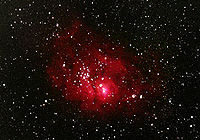Lagoon fog
| Emission nebula | |
|---|---|
| Data of the Lagoon Nebula
|
|

|
|
| Image of the Lagoon Nebula with the MPG / ESO 2.2 m telescope | |
| AladinLite | |
| Constellation | Sagittarius |
|
Position equinox : J2000.0 , epoch : J2000.0 |
|
| Right ascension | 18 h 03.6 m |
| declination | −24 ° 23 ′ |
| Appearance
|
|
| Apparent brightness (visual) | 6.0 likes |
| Angular expansion | approx. 90 ′ × 35 ′ |
| Ionizing source | |
| designation | NGC 6530 |
| Type | Star clusters |
| Physical data
|
|
| Affiliation | Milky Way |
| Redshift | 0.000013 |
| Radial velocity | 3.8 km / s |
| distance | 5200 ly (1600 pc ) |
|
history
|
|
| discovery | Giovanni Battista Hodierna |
| Date of discovery | before 1654 |
| Catalog names | |
| NGC 6523, 6526, 6530 • M 8 • OCISM 1 • W 29 | |
The Lagoon Nebula (also called Messier 8 or NGC 6523 ) is a structure of emission and reflection nebula with a brightness of 6.0 mag and an angular extent of about 90 ′ × 35 ′ in the constellation Sagittarius . It is about 5200 light years from the sun .
morphology
The Lagoon Nebula is a large star formation area and contains several dark protostellar clouds, known as globules , with a diameter of around 10,000 AU . In the optically brightest part of the mist is a region, which because of their appearance hourglass fog is called (not to be confused with the also hourglass mist said planetary mist MyCn 18).
In the center of the nebula is the young open star cluster NGC 6530, which was created from the material of the nebula and is now making it glow.
observation
The Lagoon Nebula is the second brightest gas nebula visible in Central Europe and an easy-to-find binoculars object.
discovery
The nebula was discovered in 1654 by Giovanni Battista Hodierna and rediscovered in 1680 independently by John Flamsteed , who is also credited with the discovery of the open star cluster NGC 6530 inside . In 1746 it was described by Jean-Philippe de Chéseaux and in 1747 by Guillaume Le Gentil . Wilhelm Herschel's observations in 1784 led to further cataloging; the southernmost part under NGC 6526 , the irregular eastern part under NGC 6533 .
Web links
- ESO: GigaGalaxy Zoom. (+ Photos & animation) September 28, 2009
- ESO: VISTA's deep look into the blue lagoon (+ photos, map & animation) January 5th, 2011
- astronews.com: Picture of the day April 26, 2018
- Spektrum.de : Amateur recordings [1]
Individual evidence
- ↑ a b SIMBAD
- ↑ a b c Messier 8 at Students for the Exploration and Development of Space
- ↑ Mike Inglis (2017): Astronomy of the Milky Way: The Observer's Guide to the Northern Sky , p. 29
- ^ Courtney Seligman: New General Catalog Objects: NGC 6500 - 6549. Retrieved August 31, 2016 (English, NGC 6526).
- ^ Courtney Seligman: New General Catalog Objects: NGC 6500 - 6549. Retrieved September 7, 2016 (English, NGC 6533).


